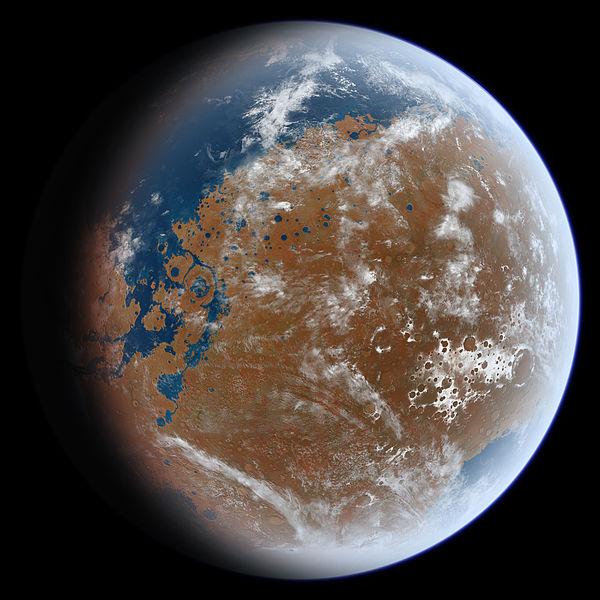New analysis of Martian rocks has one researcher saying long ago, Mars had significant quantities of free oxygen in the atmosphere.
BBC — “What we have shown is that both meteorites and surface volcanic rocks are consistent with similar origins in the deep interior of Mars, but that the surface rocks come from a more oxygen-rich environment, probably caused by recycling of oxygen-rich materials into the interior,” Prof Wood explained.
“This result is surprising because while the meteorites are geologically ‘young’, around 180 million to 1.4 billion years old, the Spirit rover was analysing a very old part of Mars, more than 3.7 billion years old.”
Whilst the researchers conceded that large regional variations in the geological composition of Mars could not be ruled out, they argue in their paper that these differences arose via subduction – in which rocks are recycled in the planet’s interior.
This is quite interesting. For one thing the presence of free diatomic oxygen, a highly reactive and unstable gas, if detected on an exoplanet, might be taken for signs of life. But that’s not what researchers think happened on Mars.
Reading between the lines and making some guesses, the story might go something like this: after late heavy bombardment brought water to Mars about 4 billion years, along with the other inner worlds including earth, Mars was warm and wet with a much thicker atmosphere than it has today. In fact conditions might have been such that a human could have safely stood on this ancient Martian surface wearing nothing but an oxygen mask — the same person today would freeze to death in seconds while blood boiled out of their lungs due to the near vacuum. Ironically, Mars could have been a lot more hospitable to humans than earth was at the time, with fluffy white clouds sandwiched between blue oceans and blue skies. The earth’s surface was probably very warm, virtually boiling hot perhaps, probably pitch-black under a crushing atmosphere rife with toxins.
But Mars is much smaller than earth and is thought to be less metallic even by proportion, with only about one-seventh the volume of our planet. That’s a critical difference. Models show it would have lost its internal heat quickly. As the core cooled and solidified, the iron dynamo at the center crapped out and the magnetic field produced by gooey spinning metal waned. Even though Mars is farther away from the sun than earth, the loss of that field would have bared the Martin atmosphere to the full brunt of the solar wind. The atmosphere was literally blasted into space, the pressure dropped. Lakes and oceans would have evaporated and sublimated; for awhile the injection of water vapor into the atmosphere might have kept pace with that lost through solar radiance.
But the water wapor leaked away into space too, for the same reason, and what was left behind met an equally final fate: high in the Martian stratosphere ultraviolet light would have split the water into hydrogen and oxygen. The lighter hydrogen promptly escaped leaving the O2 behind. Viola, there’s your oxygen source. Over time oxygen would have reacted with anything it touched, that’s what oxygen does. Iron would have rusted out in the dwindling oceans and on the dry surface, leaving behind a bands of iron oxides and ruddy oxide rich sand. The Mars we see today.
Whether this is accurate or not and exactly how high the O2 levels got at their peak is unclear. It’s unlikely oxygen would have reached the 22% levels we enjoy. But just a point or two of free oxygen would do the trick and that’s certainly plausible based on what we know now. Another irony, that oxygen could have well knocked apart any complex carbon based molecules and/or killed off any early microorganisms utilizing them, just as it may have done on earth billions of years ago. The difference being earth kept its water and life adapted.
We may yet find a few microorganisms eking out a living in pockets of ice and water just beneath the sand. But Mars dried, the oceans died, and most life that may have arisen in the primeval Martian oceans probably died out with them.


Barsoom was a thing! I knew it!
..Dang it, now I want to go back and read all the old ERB books. Preferably the ones with the awesome Michael Whelan cover art.
One day humans will slam dunk some icy comets at Mars and see how well the resultant atmosphere sticks. Should be fun.
If only Mars had a bit more mass, enough for plate tectonics a magnetic field and retention of a lot more atmosphere. What might have been. Sigh.
@1. Nice Ogress : Barsoom, Malancadra and many other names besides. I still hope one day perhaps in as little as a hundred years or two we’ll find some people call it home.
@2. Lofty : Why stop at comets?> mars needs lots of mass – maybe if we can divert a few large Trans-Neptunean planetoids full of water, metals and volatiles into a collision course we can really make it big! I’m thinking something like Sedna or Makemake even Eris here.
I don’t mean to be a pedantic nitpicker (this is actually a great article), but I believe this is an old misconception about what would happen to an unprotected human body in a vacuum–
If you don’t want to buy them, gutenberg.org and Amazon have pretty much everything ERB ever wrote. For free.
I suspect that the planning commission would have a thing or two to say about that! They generally frown on using explosives in a residential neighborhood and I think you can’t find a blanket big enough to catch all the debris.
Wonderful imagery! It reminded me of what happened to the alternator in my car.